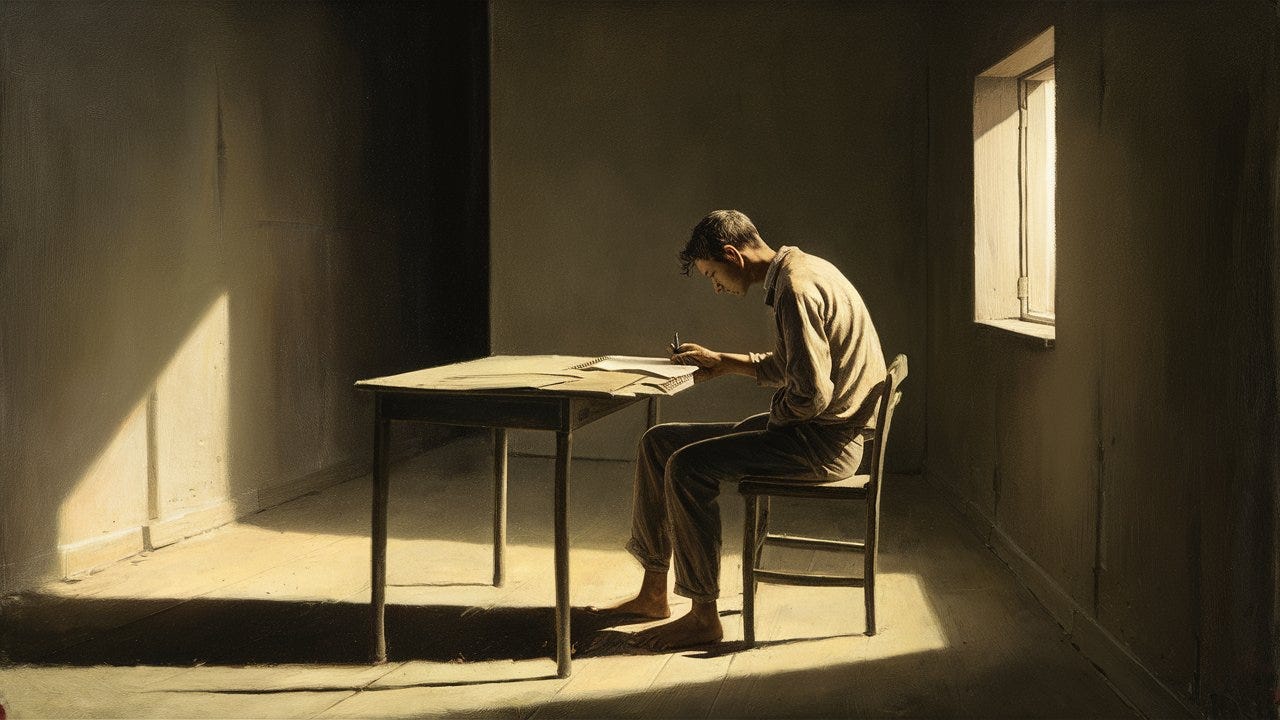A Man Alone in a Room
How AI reflects us at our most solitary... And how that might be changed
A man sits alone in a room. Before him are the tools of his trade: a quill pen/ink pen/typewriter/laptop. Parchment/paper/screen. He is in solitude, in his thoughts, in his head, in silence. Perhaps he can hear the distant hum of cloistered monks as they go about their business. Perhaps he wears noise-cancelling headphones. Whatever the context, it is only him, in a bubble, preparing to write.
Until the start of the 19th century, this was how most of human life was recorded. History, science, literature: the product of men sitting alone in rooms, writing books, plays, and poems. Plato recorded the dialogues of Socrates, likely sitting alone in a room. Shakespeare's plays, partly written ‘on the fly’ as the Lord Chamberlain’s men rehearsed, were then redrafted, augmented, and improved by the Bard. Alone, in a room.
While there were female outliers such as Hildegard of Bingen, Julian of Norwich and Aphra Behn, it was only really from the start of the 19th century that women entered the writing scene in any great number. There was a flourishing of women writers, from the Wollstonecrafts through to Austen, the Brontës, Eliot and Woolf – all of them finally able to find ‘a room of their own’, to paraphrase the title of Woolf’s seminal work. As Woolf explains:
“In the first place, to have a room of her own, let alone a quiet room or a sound-proof room, was out of the question, unless her parents were exceptionally rich or very noble, even up to the beginning of the nineteenth century. [...] The indifference of the world which Keats and Flaubert and other men of genius have found so hard to bear was in her case not indifference but hostility. The world did not say to her as it said to them, Write if you choose; it makes no difference to me. The world said with a guffaw, Write? What's the good of your writing?”1
It was only with the rise of the middle classes, and access to education, money and space, that enabled women like Austen and the Brontës the time, freedom and place to write. By a simple process of deduction, this means that most uploaded historical content was written by solitary men.
The endless loop of creation and reaction
Today, most of the content produced online comes from men and women, alone, with their phones or laptops, creating, commenting, arguing, trolling, supporting and criticising. The algorithm wants us to create and react, create and react, create and react. It needs to be fed, and we are the ones to feed it. Most of it happens asynchronously, affording us time to think of what to create, how to react. When we get it wrong it can haunt us for the rest of our lives: the rushed, ill-considered Tweet or compromising video can ruin careers, lives even. But when we take a step back and consider the conditions of production, we realise one thing: it’s all us, alone in our heads, alone in our echo chamber, creating and reacting in an endless loop.
Whilst it’s a little more even than through history, more online content is created by men than women: year on year it is estimated to be around 55% to 45% male to female2. Based on my experience of LinkedIn and Twitter, that does not surprise me one bit. This all adds up: based on the sheer volume of male-created content historically, Perplexity estimates that the bias of male-created data over female could be as much as 80:203.
Whether male or female, we can fairly safely assert that the majority of the content online is the creation of people alone in rooms. Creating and reacting. It is not the product of face-to-face discussion, debate, meandering chats that go nowhere, the loving words of a mother to her son, the comfort a son gives to his dying father, or the snaking conversations we have over dinner or at the pub. This shared, synchronous language, the words that bind us, aren’t online as they are seldom recorded. Phatic conversation, small talk, idle chat: it is not there. And yet it is the glue that holds the human race together.
AI and Solitude
It is only when we consider how AI is trained that a realisation hits us: AI’s ‘intelligence’ is the creation of solitude, not social interaction. Because of the conditions of production, AI cannot help but reflect who we are when we are alone, either creating or reacting. This essay is a case in point. Me, sitting in Waterstones café on a Saturday morning, my family away in Latvia, affording me the time and space to write. I would not be writing this were I at home with noise and activity around me. I would likely not even have had the insight that I had this morning as I was walking alone through town. These words may never have been written. And once posted, future AI models will likely use them as part of its training set.
We know that so many ideas are the product of a meeting of minds. Seldom are insights born in a vacuum. We will take what we gain from meeting others into our writing. But we will always colour those ideas once we begin to capture them in words, the solitary act of writing making them our own. This constant, onanistic process is pushed repeatedly online, compounding solitude on solitude. I write alone, I read alone, I react alone. The moment my fingers dance on the keyboard, the hurried response to a post using my touchscreen iPhone, the reaction post to something I read: all of them me and the laptop, me and the touchscreen. I read comments of support and feel a tinge of satisfaction. I read criticism and feel a touch of irritation and defensiveness. And I respond, alone, and so it goes on.
Solitude feeding the machine, seemingly without end.
How Solitude Eats Itself
And now we have generative AI creating content that is already being fed back into itself, an act of cannibalism that (like a shallow gene pool) can cause intellectual degradation. The solitary product of an algorithmic process, the black box weighting the probable next word in a sentence based on its being trained on content largely created by men alone in rooms. Solitude eating itself.
It doesn’t end there: There is further compounding through reinforcement learning by human feedback: solitary individuals (often in poorer countries) reading AI’s output and grading its suitability for public consumption. And guess what? The final arbiters of what AI is allowed to show us come from decisions made by (largely) solitary men. A man, alone in a room, passing judgement before the model is released to the public.
Video as Thought in Action
So how can we change this? Perhaps multi-modal AI will enable a broader range of human experience to be captured. I am sure that, if the video contents of YouTube, TikTok and Instagram were used to train AI, it would create a more holistic model. It is mediated, sure, and does not fully replicate the richness of lived daily experience. But it is at least halfway there, moving as it does beyond the vast amount of solitarily produced data on which AI is currently trained. Video is better at recording thoughts in action, us embodied in the world.
I’m not criticising men alone in rooms, writing. I am one of them. I gain much from writing, as it is part of my thinking process. I seldom know what I will end up with when I begin to write. We would not have made the progress that has shaped the world without having the solitary freedom to capture ideas on paper. But we cannot expect AI to represent all of us until we offer it all of ourselves, from the sweet nothings we utter when we first fall in love to Descartes’ Meditations and the Bhagavad Gita.
The written word is the creation of man’s desire for solitude. Brilliant thoughts are seldom generated from noisy conditions. Therefore, it is sensible to assume that AI, at its core, represents us at our most alone. And that, if we are to evolve AI, it needs more than this. It needs to get social.
Woolf, Virginia. A Room of One's Own. Penguin Books, 2004
https://www.zippia.com/content-creator-jobs/demographics/
Estimating the Percentage of AI Training Data Created by Men vs. Women (Perplexity using Llama-3.1 405B):
Based on the provided search results and analysis, it's possible to make an educated estimate of the percentage of AI training data created by men vs. women.
Historical Writing
Historical writing has been dominated by men, with women's voices and perspectives often being marginalized or excluded. While it's difficult to estimate the exact percentage, it's likely that men have contributed significantly more to historical writing than women.
Online Posting and Commenting
Online posting and commenting have become more diverse in recent years, but men still dominate online platforms. According to a study on online harassment, men are more likely to participate in online discussions and commenting.
AI Training Data
AI training data is often sourced from various places, including books, articles, research papers, and online content. Given the historical dominance of men in writing and the continued male dominance in online platforms, it's likely that AI training data is also biased towards male perspectives.
Estimating the Breakdown
Based on the available information, a rough estimate of the breakdown of AI training data created by men vs. women could be:
* Men: 70-80%
* Women: 20-30%
This estimate is based on the historical dominance of men in writing, the continued male dominance in online platforms, and the underrepresentation of women in the AI field.




